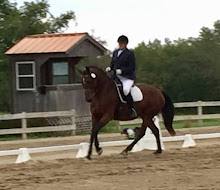I have been taking several clinics with Lientje Schueler, which has really made a difference in my riding.
I have had over the years a global problem asking my horses to go into an uphill frame and to stay there. I see many horses at horse shows with flat backs and high necks doing all of the movements but in a really stiff way. I know I have always hesitated to push my horses past where the point that I lose the feeling of their back swinging. I have always felt that an uphill balance with a frozen back is not what I am looking for. It turns out I was right but had no idea how to get uphill without losing the swing of the horse's back.
Many clinicians have you force the horse to work uphill - but then you get an inactive back in your horse. Others never try to help you with longitudinal balance because it is simply too hard. Lientje has step by step process on how to keep the topline relaxed while riding your horse in an uphill dressage balance.
Step one is to be able to push the haunches in whenever you want to and whenever you need to. This needs to be there not because it is the fix but because it supports the solution.
Step two is to ask the horse to move its shoulders to the outside of the circle and flex the neck at will. (Note that if you nave no influence on the haunches - they will just sneak to the outside of the circle.) Another part of step two is to be able to move the shoulders to the inside of the circle at will. Note that in this situation the rider must still be able to hold the haunches where they are needed.
I was doing 1/2 pass in my last lesson in the trot and we played with speeding up the shoulders or slowing them down. (In the past I just stabilized the shoulder and adjusted the haunches.) The ability to ride more lateral flexibility into the shoulders allows the horse to have a more supple topline overall. WOW!
The horse I have been riding has a very good trot and I seem to be able to teach her about collection there and then transfer it to the canter. For example, she is willing to Piaffe and that helps her understand that she needs to use her belly for collection. Anything you can get your horse to understand in one gait will help the other gaits.
The two most important things, teach them in the gait where they can hear you the best and very importantly, find a way to access the lateral flexibility of the shoulder!
Have a great ride every time!
Tuesday, December 13, 2011
Subscribe to:
Post Comments (Atom)

No comments:
Post a Comment
Note: Only a member of this blog may post a comment.